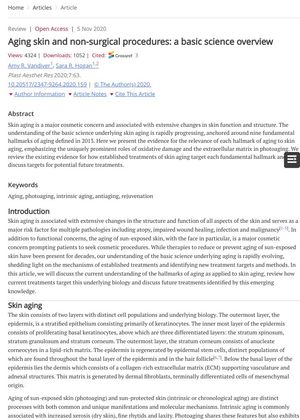Aging Skin and Non-Surgical Procedures: A Basic Science Overview
January 2020
in “
Plastic and Aesthetic Research
”

TLDR Non-surgical procedures can help reduce wrinkles and stimulate skin repair by understanding skin aging at the molecular level.
The 2020 document "Aging skin and non-surgical procedures: a basic science overview" examined the biological processes involved in skin aging and the effectiveness of non-surgical procedures to counteract these changes. The study identified skin aging as a complex process influenced by both genetic and environmental factors, leading to changes such as reduced collagen and elastin production, and increased oxidative stress. Non-surgical procedures like laser treatments, chemical peels, and dermal fillers were found to stimulate the skin's natural repair mechanisms, promote collagen production, and reduce the appearance of wrinkles. The study also discussed the role of UV-induced reactive oxidative species (ROS) in initiating cutaneous aging phenotypes. Treatments aimed at improving mitochondrial function and reversing nutrient abundance signals, including supplementation with antioxidants like coenzyme Q10 and nicotinamide, and the use of resveratrol, were discussed. The document concluded that understanding the molecular mechanisms of skin aging can help in the development of effective treatments.
